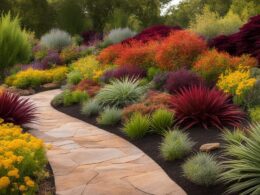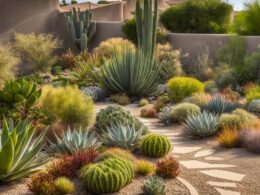Xeriscaping is a landscaping technique that focuses on creating water-efficient gardens using native desert plants. By implementing xeriscaping principles, you can transform your home garden into a sustainable oasis that thrives in arid climates. In this practical guide, we will provide you with expert tips and advice on how to master the art of xeriscaping.
Key Takeaways:
- Xeriscaping is a landscaping technique that utilizes native desert plants for water efficiency.
- Implementing xeriscaping principles can help create a sustainable and low-maintenance garden.
- Selecting appropriate drought-tolerant plants and grouping them by water needs is crucial for efficient irrigation.
- Mulching plays a significant role in moisture retention and weed suppression in xeriscape gardens.
- Efficient irrigation methods, such as drip irrigation, can minimize water waste and conserve water resources.
Understanding the Need for Xeriscaping in Dry Climates
In dry climates like the Puget Sound area in Washington State, water scarcity is a significant concern. With limited rainfall and dry summers, it becomes crucial to adopt water conservation practices in gardening. This is where xeriscaping comes in. Xeriscaping is a landscaping technique that focuses on creating water-efficient gardens using native desert plants. By understanding the need for xeriscaping in dry climates, you can contribute to water conservation efforts while still enjoying a beautiful garden.
Xeriscaping is particularly important in regions with low rainfall and extended periods of dry weather. The Puget Sound area, for example, receives only about a third of its yearly rainfall between April and September. With such limited water availability during the growing season, it becomes necessary to find alternative ways to sustain plant life without relying heavily on irrigation. Xeriscaping offers a solution by utilizing plants that are adapted to arid conditions and minimizing water usage through strategic design and efficient irrigation methods.
Implementing xeriscaping techniques not only helps conserve water but also promotes the sustainability of the ecosystem. By using native desert plants, you can create a garden that is well-suited to the local climate and requires minimal watering. These plants have evolved to survive in arid conditions, making them more resilient and better adapted to the region’s environmental challenges. By reducing the demand for water-intensive plants and introducing native species, you can help preserve the delicate balance of the local ecosystem.
In the next section, we will explore the principles of xeriscaping in more detail and provide practical tips for planning and designing your own water-efficient garden. By understanding the foundation of xeriscaping, you will be equipped with the knowledge to create a sustainable and beautiful landscape that thrives in dry climates.
The Importance of Xeriscaping in Dry Climates:
“Xeriscaping is an essential practice in dry climates like the Puget Sound area. By utilizing water-efficient landscaping techniques and native desert plants, you can create a beautiful garden while conserving precious water resources.”
The Principles of Xeriscaping
Xeriscaping, also known as water-wise landscaping, is based on seven fundamental principles that can guide you in creating a beautiful and sustainable garden. By following these principles, you can reduce water consumption, minimize maintenance, and create an eco-friendly landscape.
1. Planning and Design
The first principle of xeriscaping is careful planning and design. Before you start planting, take the time to analyze your property and understand its unique characteristics. Consider factors such as sunlight, soil type, and water availability. By designing your garden with these factors in mind, you can create an efficient and visually appealing landscape.
2. Soil Amendment
The second principle involves soil amendment. It is crucial to improve the quality of your soil to ensure optimal plant growth and water retention. Test your soil’s composition and make necessary amendments such as adding organic matter or improving its drainage. By improving the soil, you can create an environment that supports healthy plant growth and maximizes water efficiency.
3. Practical Turf Areas
While turf areas can provide functional spaces for activities like playing or entertaining, it is essential to use them sparingly in xeriscaping. Avoid extensive lawns that require excessive water and maintenance. Instead, focus on creating practical turf areas that serve your specific needs while minimizing water consumption.
4. Appropriate Plant Selection
Choosing the right plants is a key aspect of xeriscaping. Select plants that are native to your region and well-adapted to its climate and water availability. Native plants are typically more drought-tolerant and require less watering than exotic species. Group plants with similar watering needs together to ensure efficient irrigation and optimal plant health.
5. Use of Mulches
Mulching is an essential practice in xeriscaping as it helps conserve moisture, suppress weeds, and regulate soil temperature. Applying a layer of organic mulch around your plants can reduce water evaporation from the soil, keeping it moist for longer periods. Mulching also helps prevent weed growth, reducing competition for water and nutrients.
6. Efficient Irrigation
Efficient irrigation is a crucial principle in xeriscaping. Traditional sprinkler systems can waste a significant amount of water through evaporation and runoff. Consider installing drip irrigation, which delivers water directly to the roots of plants, minimizing water waste. Drip irrigation is not only more water-wise but also contributes to healthier plant growth.
7. Proper Maintenance
The final principle of xeriscaping is proper maintenance. Regularly inspect your garden for signs of water stress, pests, or diseases. Remove weeds promptly to prevent them from competing with your plants for water. By following proper maintenance practices, you can ensure the long-term sustainability and beauty of your xeriscape garden.
Table: Principles of Xeriscaping
| Principle | Description |
|---|---|
| Planning and Design | Carefully analyze your property and design a landscape that factors in sunlight, soil type, and water availability. |
| Soil Amendment | Improve soil quality by adding organic matter and addressing drainage to support healthy plant growth. |
| Practical Turf Areas | Create functional turf areas while minimizing water consumption and maintenance requirements. |
| Appropriate Plant Selection | Select native and drought-tolerant plants adapted to your region’s climate and water availability. |
| Use of Mulches | Apply organic mulch around plants to conserve moisture, suppress weeds, and regulate soil temperature. |
| Efficient Irrigation | Install drip irrigation systems to deliver water directly to plant roots, minimizing waste. |
| Proper Maintenance | Regularly inspect and maintain your xeriscape garden to ensure its long-term sustainability. |
Planning and Designing Your Xeriscape Garden
When it comes to creating a beautiful and water-efficient xeriscape garden, careful planning and thoughtful design are key. By considering factors like light, water, wind, drainage, and soil type, you can create a landscape that thrives in your specific environment. Let’s explore the essential steps to help you plan and design your xeriscape oasis.
1. Assess Your Property
Start by evaluating your property and understanding its unique characteristics. Consider the sun exposure throughout the day, the natural water flow, areas with shade, and any slopes or flat surfaces. This assessment will help you determine the best locations for different types of plants and features in your xeriscape garden.
2. Develop a Solid Plan
Next, develop a comprehensive plan that outlines the layout and design of your xeriscape garden. Sketch out different areas, such as seating areas, paths, and planting beds. Take into account the natural flow of the space and create a design that is visually appealing and functional. Remember to incorporate elements that conserve and maximize water usage, such as rainwater harvesting systems and efficient irrigation methods.
3. Create Hydrozones
One of the essential principles of xeriscaping is grouping plants with similar watering needs together in hydrozones. This helps optimize water usage by allowing you to water each zone according to its specific requirements. Divide your garden into different hydrozones based on the water needs of the plants, such as low-water, moderate-water, and high-water zones. This approach ensures efficient irrigation and reduces water waste.
4. Choose Suitable Plants
When selecting plants for your xeriscape garden, prioritize native and drought-tolerant species that are well-adapted to your region’s climate. These plants are more likely to thrive with minimal water input and require less maintenance. Consider their growth habits, mature size, and color to create a visually appealing and harmonious garden. Integrate a variety of plant types, including groundcovers, shrubs, and trees, to add depth and texture to your landscape.
5. Consider Hardscaping Elements
In addition to plants, hardscaping elements like pathways, patios, and decorative features can enhance the overall design of your xeriscape garden. Use materials that complement the natural surroundings and require minimal maintenance. Incorporate features like permeable paving materials to allow water to penetrate the soil and reduce runoff. These elements add structure and functionality to your landscape while minimizing water usage.
6. Incorporate Sustainable Practices
As you plan and design your xeriscape garden, keep sustainability in mind. Consider incorporating environmentally friendly practices like composting, which enriches the soil and reduces waste. Choose materials and products that are locally sourced and have a minimal environmental impact. By embracing sustainable practices, your xeriscape garden will not only conserve water but also contribute to the overall health of the ecosystem.
With thoughtful planning and design, you can create a stunning xeriscape garden that thrives in your specific environment while conserving water and minimizing maintenance. By embracing the principles of xeriscaping and incorporating sustainable practices, you’ll create a landscape that is not only visually appealing but also environmentally friendly.
Enhancing Soil Through Amendment
When it comes to xeriscaping, one of the critical aspects is enhancing the soil through amendment. By improving the soil composition and structure, you can create a foundation that promotes water-holding capacity and nutrient availability for your plants. Testing the soil for texture, water-holding capacity, and nutrient content is the first step in determining if amendments are necessary.
If the soil lacks organic matter or has poor drainage, incorporating organic amendments like compost, leaves, or aged manure can greatly improve its water-holding capacity. These organic materials help the soil retain moisture, allowing plants to access water even during dry periods. Additionally, they contribute to the overall health of the soil by providing essential nutrients and promoting beneficial microbial activity.
Benefits of Soil Amendment in Xeriscaping:
- Improved water retention and reduced water loss through evaporation
- Enhanced nutrient availability for plants
- Increased soil aeration and root penetration
- Promotion of beneficial microbial activity
By amending the soil, you create an environment that supports healthy plant growth and reduces the need for frequent watering. It is important to note that the amount and type of amendment required may vary based on your specific soil composition and plant selection. Consider conducting a soil test or consulting with a local gardening expert to determine the best approach for your xeriscape garden.
Incorporating Practical Turf Areas in Xeriscaping
Turf areas can still have a place in xeriscaping if they serve a practical purpose, such as high-traffic areas for entertaining or playing. However, it’s crucial to avoid filling gaps with turfgrass where there is no practical need. Consider alternatives like groundcover plants that require less water and maintenance. By carefully evaluating your landscape and identifying areas that truly require turf, you can optimize water usage and create a more sustainable xeriscape garden.
When incorporating turf areas into your xeriscape design, it’s important to select grass species that have low water requirements. Native warm-season grasses like Buffalo grass or Blue grama grass are excellent choices as they are adapted to the local climate and have natural drought tolerance. These grasses have deep root systems that allow them to thrive in arid environments, reducing the need for frequent watering.
Proper maintenance of turf areas is also essential to ensure their practicality in xeriscaping. Regularly mowing the grass at a higher setting can promote deeper root growth and improve water efficiency. It’s important to avoid overwatering and only provide irrigation when necessary. By following these practices, you can have functional turf areas in your xeriscape garden while still conserving water and maintaining a sustainable landscape.
Table: Comparison of Turfgrass Species for Practical Turf Areas
| Turfgrass Species | Water Requirements | Maintenance Level | Drought Tolerance |
|---|---|---|---|
| Buffalo grass | Low | Low | High |
| Blue grama grass | Low | Low | High |
| Tall fescue | Moderate | Moderate | Moderate |
| Zoysia grass | Moderate to High | Moderate to High | Moderate to High |
Table: A comparison of turfgrass species commonly used in practical turf areas for xeriscape gardens. The water requirements, maintenance level, and drought tolerance are indicated to help homeowners make informed decisions about the most suitable grass species for their needs.
Selecting Appropriate Drought-Tolerant Plants
When it comes to xeriscaping, selecting the right plants is crucial for a successful and water-efficient garden. Native plants that are adapted to the local climate and have a high tolerance for drought conditions are the ideal choice. These plants are naturally suited to the region’s soil, rainfall patterns, and temperature fluctuations, making them more resilient and requiring less water.
By choosing native plants, you can create a xeriscape garden that thrives with minimal maintenance and water consumption. Native plants have already adapted to the local ecosystem, making them more resistant to pests and diseases, and reducing the need for chemical intervention. Additionally, these plants provide essential habitat and food for local wildlife, supporting the biodiversity of your surroundings.
Drought-tolerant plants come in a variety of sizes, colors, and textures, allowing you to create a visually appealing and diverse landscape. It’s important to consider the specific water needs of each plant and group them accordingly. By creating hydrozones based on water requirements, you can optimize irrigation and ensure that each plant receives the right amount of water without waste.
Native Plants for Xeriscaping
| Plant | Water Requirement | Sun Exposure | Height |
|---|---|---|---|
| Desert Marigold (Baileya multiradiata) | Low | Full sun | 1-2 feet |
| Prickly Pear Cactus (Opuntia spp.) | Very low | Full sun | 2-10 feet |
| Blackfoot Daisy (Melampodium leucanthum) | Low | Full sun | 6-12 inches |
| Globe Mallow (Sphaeralcea spp.) | Low | Full sun | 2-4 feet |
These are just a few examples of native desert plants that are suitable for xeriscaping. However, it’s essential to research and select plants that are native to your specific region, as the climate and soil conditions can vary. Consult local gardening resources or seek advice from professionals to ensure you choose the right plants for your xeriscape garden.
The Importance of Mulching in Xeriscaping
When practicing xeriscaping, one of the key elements to consider is mulching. Mulching serves multiple purposes in a water-efficient garden, including moisture retention, weed suppression, and soil temperature regulation. By applying a layer of organic material on the soil surface, you can greatly enhance the health and vitality of your xeriscape garden.
Mulching plays a crucial role in moisture retention. The layer of organic material acts as a barrier, reducing evaporation and minimizing water loss from the soil. This helps to keep the soil moist for a longer period, ensuring that plants have access to the water they need even during dry spells. Additionally, mulching helps to regulate soil temperature, keeping it cooler during hot summer days and warmer during chilly nights.
Another benefit of mulching is its ability to suppress weeds. By creating a physical barrier between the soil surface and sunlight, mulch prevents weed seeds from germinating and emerging. This reduces the competition for resources, allowing your xeriscape plants to thrive without having to compete with unwanted vegetation. Additionally, mulching helps to inhibit weed growth by preventing weed seeds from being dispersed by wind or water.
The Benefits of Mulching in Xeriscaping:
- Moisture retention: Mulching reduces evaporation and helps to keep the soil moist for longer periods, promoting healthy plant growth.
- Weed suppression: By blocking sunlight and inhibiting weed seed germination, mulch helps to minimize weed growth in your xeriscape garden.
- Soil temperature regulation: Mulching helps to maintain a more stable soil temperature, protecting plant roots from extreme heat and cold.
Types of Mulch for Xeriscaping:
| Organic Mulch | Inorganic Mulch |
|---|---|
| Examples: Compost, wood chips, straw, leaves | Examples: Gravel, crushed stone, rubber mulch |
| Benefits: Adds organic matter to the soil, improves soil structure, and provides nutrients as it breaks down. | Benefits: Durable, doesn’t break down over time, provides a clean and consistent appearance. |
| Considerations: May need replenishment over time as it decomposes. | Considerations: Can heat up in direct sunlight, potentially increasing soil temperature. |
“Mulching is a game-changer for xeriscaping. It helps to conserve water, suppress weeds, and create a favorable environment for plant growth. Without proper mulching, your xeriscape garden may struggle to thrive in dry climates.”
Overall, mulching is an essential practice in xeriscaping as it provides numerous benefits for your water-efficient garden. From moisture retention to weed suppression, mulch plays a vital role in creating a healthy and sustainable landscape. Consider the type of mulch that suits your needs and the specific requirements of your xeriscape garden. With proper mulching, you can maximize the success of your xeriscaping efforts.
Efficient Irrigation Methods for Xeriscaping
Efficient irrigation is a crucial component of successful xeriscaping. By implementing water-conserving techniques, you can minimize water waste and ensure that your plants receive the necessary moisture to thrive. One highly recommended method for xeriscaping is drip irrigation.
Drip irrigation delivers water directly to the root zone of your plants, reducing water loss through evaporation or runoff. This targeted approach maximizes water efficiency and minimizes waste. With drip irrigation, you can also prevent water from reaching unnecessary areas such as walkways and driveways, ensuring that every drop counts.
Benefits of Drip Irrigation:
- Water Conservation: Drip irrigation significantly reduces water usage by delivering water precisely where it’s needed, minimizing evaporation and runoff.
- Plant Health: By providing water directly to the roots, drip irrigation promotes healthier plants with stronger root systems.
- Weed Control: Since the water is delivered directly to the plant’s root zone, there is less moisture available for weeds to germinate and grow.
- Reduced Maintenance: Drip irrigation systems require less maintenance compared to traditional sprinkler systems, saving you time and effort.
- Flexibility: Drip irrigation allows for flexible watering schedules, making it easy to adjust the amount and frequency of water based on the specific needs of your plants.
Installing a drip irrigation system may require some upfront investment, but the long-term benefits far outweigh the initial cost. Not only will you conserve water and reduce your environmental impact, but you’ll also enjoy a healthier, more vibrant garden. Consider consulting with a professional landscaper or irrigation specialist to design and install a drip irrigation system that suits your xeriscape garden’s specific needs.
Conclusion
Xeriscaping with native desert plants offers a practical and sustainable approach to gardening. By implementing the principles of xeriscaping, you can create a beautiful and water-efficient xeriscape garden that not only reduces water consumption but also minimizes maintenance and supports the local ecosystem.
To create an effective xeriscape garden, start by carefully planning and designing your landscape. Consider factors like light, water, wind, drainage, and soil type to optimize your garden’s success. Grouping plants with similar watering needs into hydrozones will help you efficiently irrigate your garden and conserve water.
When selecting plants for your xeriscape garden, choose native and drought-tolerant species that are well-suited to your local climate. These plants require minimal maintenance and can thrive with less water. Additionally, incorporating practical turf areas only where necessary and using groundcover plants as alternatives will further reduce water requirements.
Mulching is a crucial element in xeriscaping as it helps retain soil moisture, suppresses weeds, and regulates soil temperature. By applying a layer of organic material on the soil surface, you can significantly reduce water loss through evaporation and minimize the need for frequent watering.
In terms of efficient irrigation methods, consider installing a drip irrigation system. This method delivers water directly to the plant’s root zone, minimizing water waste through evaporation or runoff. By adopting these practices, you can create a sustainable xeriscape garden that conserves water, minimizes maintenance, and promotes a thriving ecosystem.
How Can I Incorporate DIY Xeriscaping Irrigation Methods with Native Desert Plants?
Looking to incorporate DIY xeriscaping irrigation methods with native desert plants? Check out our xeriscaping irrigation methods tutorial for step-by-step instructions on how to conserve water while maintaining a beautiful and sustainable landscape. With the right techniques, you can create a thriving garden that’s easy to maintain in a dry climate.
FAQ
What is xeriscaping?
Xeriscaping is a landscaping technique that focuses on creating water-efficient gardens using native desert plants.
Why is xeriscaping important in dry climates?
Xeriscaping is important in dry climates because it helps conserve water and maintain thriving gardens despite limited rainfall.
What are the principles of xeriscaping?
The principles of xeriscaping include planning and design, soil amendment, practical turf areas, appropriate plant selection, use of mulches, efficient irrigation, and proper maintenance.
How do I plan and design a xeriscape garden?
To plan and design a xeriscape garden, consider factors like light, water, wind, drainage, and soil type. Create hydrozones to group plants with similar watering needs and optimize irrigation.
How do I improve my soil for xeriscaping?
To improve soil for xeriscaping, assess its composition and make amendments if necessary. Test the soil for texture, water-holding capacity, and nutrient content, and add organic matter like compost or leaves to enhance water retention and nutrient availability.
Can I have turf areas in a xeriscape garden?
Yes, turf areas can have a place in xeriscaping if they serve a practical purpose, such as high-traffic areas. However, it’s important to avoid filling gaps with turfgrass where there is no practical need and consider alternatives like groundcover plants.
What plants are best for xeriscaping?
The best plants for xeriscaping are native and drought-tolerant plants that are well-adapted to the local environment. Grouping plants with similar watering needs also aids in efficient irrigation.
Why is mulching important in xeriscaping?
Mulching is important in xeriscaping as it improves soil moisture retention, suppresses weeds, and regulates soil temperature. It greatly reduces water loss through evaporation, allowing plants to thrive with less frequent watering.
What is the most efficient irrigation method for xeriscaping?
Drip irrigation is the most efficient method for xeriscaping. It delivers water directly to the plant’s root zone, minimizing water waste through evaporation or runoff. Installing a drip irrigation system ensures targeted watering while conserving water.
How does xeriscaping contribute to water conservation?
Xeriscaping with native desert plants reduces water consumption, minimizes maintenance, and supports the local ecosystem. By implementing xeriscaping principles, homeowners can create beautiful and water-efficient landscapes.














